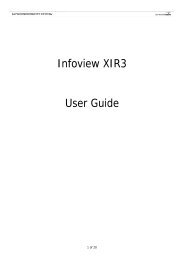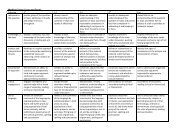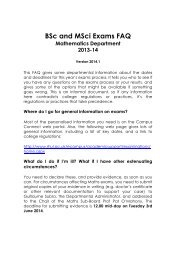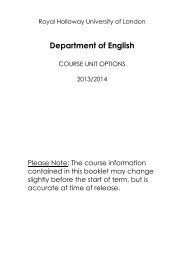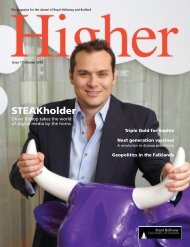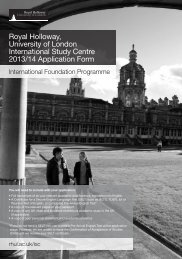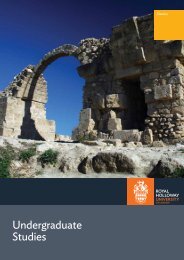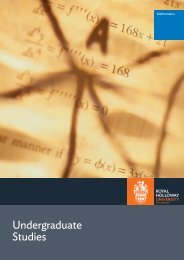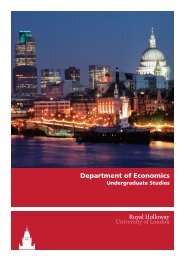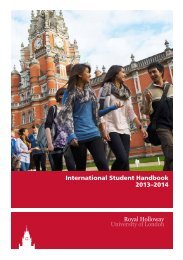a short history of the ISG - Royal Holloway, University of London
a short history of the ISG - Royal Holloway, University of London
a short history of the ISG - Royal Holloway, University of London
Create successful ePaper yourself
Turn your PDF publications into a flip-book with our unique Google optimized e-Paper software.
The Information Security Group - A Brief History<br />
A Brief History <strong>of</strong> <strong>the</strong> <strong>Royal</strong> <strong>Holloway</strong><br />
Information Security Group<br />
The Early Years<br />
In <strong>the</strong> early 1980s, <strong>the</strong> <strong>University</strong> <strong>of</strong> <strong>London</strong> was re-structured to decrease <strong>the</strong> number <strong>of</strong><br />
small colleges. <strong>Royal</strong> <strong>Holloway</strong> College merged with Bedford College to form <strong>Royal</strong><br />
<strong>Holloway</strong> and Bedford New College, but <strong>the</strong> re-structuring <strong>of</strong> Ma<strong>the</strong>matics did not follow<br />
<strong>the</strong> university plan.<br />
In <strong>the</strong> restructuring <strong>of</strong> Ma<strong>the</strong>matics it was decided that each college should be <strong>the</strong><br />
<strong>University</strong>’s research centre for one (or more) branches <strong>of</strong> <strong>the</strong> subject, and many <strong>of</strong> <strong>the</strong><br />
ma<strong>the</strong>maticians were transferred to <strong>Royal</strong> <strong>Holloway</strong> with <strong>the</strong> justification that it would<br />
become <strong>the</strong> centre for discrete ma<strong>the</strong>matics/combinatorics. At that time Fred Piper, who<br />
was head <strong>of</strong> Ma<strong>the</strong>matics at Westfield College (which subsequently merged with Queen<br />
Mary College to become Queen Mary and Westfield College), and one <strong>of</strong> his ex-PhD<br />
students Henry Beker, who was a visiting pr<strong>of</strong>essor at Westfield, had just published <strong>the</strong>ir<br />
book Cipher Systems. As a result, Fred was asked to direct <strong>the</strong> discrete ma<strong>the</strong>matics<br />
research effort at <strong>Royal</strong> <strong>Holloway</strong> with cryptography as one <strong>of</strong> <strong>the</strong> focal points.<br />
Fred and Henry transferred to <strong>Royal</strong> <strong>Holloway</strong> and Bedford New College in 1985. In order<br />
to help establish cryptography, by <strong>the</strong>n an emerging academic discipline, <strong>the</strong> College<br />
provided one new position to <strong>the</strong> Ma<strong>the</strong>matics department, which was filled by Peter Wild,<br />
also an ex-PhD student from Westfield. They were soon joined by Sean Murphy, an<br />
SERC funded RA, and a number <strong>of</strong> PhD students working on topics ranging from<br />
cryptography and coding <strong>the</strong>ory to block designs. Simultaneously cryptography was<br />
growing in ‘popularity’, and <strong>Royal</strong> <strong>Holloway</strong> was building important strategic relationships<br />
with a number <strong>of</strong> companies. (For example, <strong>the</strong> position <strong>of</strong> Head <strong>of</strong> Ma<strong>the</strong>matics at Racal<br />
Comsec was held by a succession <strong>of</strong> five people who obtained PhD degrees under Fred<br />
Piper’s supervision. The first <strong>of</strong> <strong>the</strong>se was Henry Beker, and <strong>the</strong> second was Chris<br />
Mitchell who, in 1985, moved from Racal Comsec to Hewlett Packard Laboratories in<br />
Bristol).<br />
In 1987 a number <strong>of</strong> companies came to <strong>Royal</strong> <strong>Holloway</strong> to discuss <strong>the</strong> possibility <strong>of</strong><br />
introducing an MSc in Cryptography. Fortunately (with hindsight!) it was felt that this<br />
would be too ‘narrow’, and that a degree in <strong>the</strong> wider area <strong>of</strong> Information Security would<br />
be more beneficial to industry, and produce more students for <strong>Royal</strong> <strong>Holloway</strong>. However,<br />
such a broader vocational degree, aimed at producing information security pr<strong>of</strong>essionals,<br />
required staff with much wider interests than simply cryptography.<br />
The first step towards <strong>the</strong> move from a group <strong>of</strong> specialist ma<strong>the</strong>matical cryptographers to<br />
include more general computer science/information security researchers was to recruit<br />
Chris Mitchell from Hewlett Packard in 1990. Chris was appointed as head <strong>of</strong> <strong>the</strong><br />
Computer Science Department. This was very rapidly followed by <strong>the</strong> appointment <strong>of</strong><br />
Dieter Gollmann as a second computer scientist and Sean Murphy as a Lecturer in<br />
Information Security (a shared appointment between Ma<strong>the</strong>matics and Computer Science<br />
and <strong>the</strong> first appointment with Information Security in <strong>the</strong> title).<br />
1



